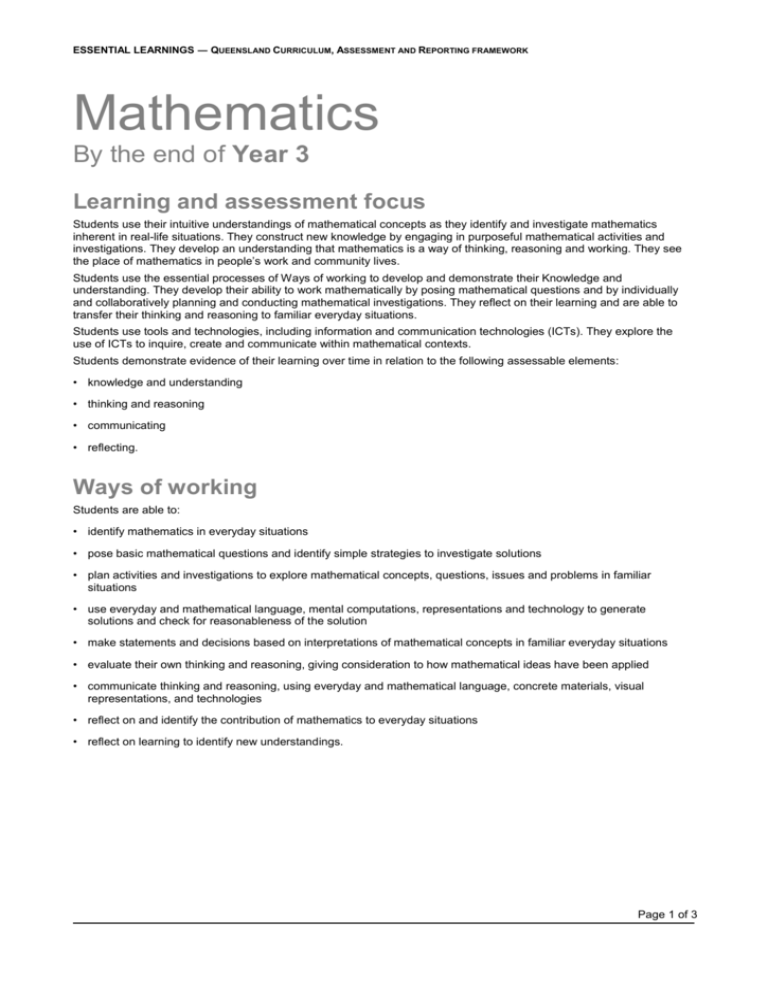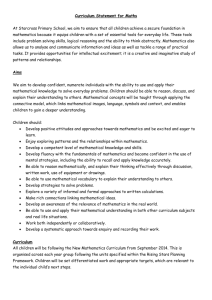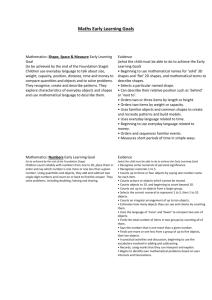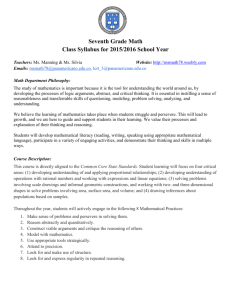Mathematics - Queensland Curriculum and Assessment Authority
advertisement

ESSENTIAL LEARNINGS ― QUEENSLAND CURRICULUM, ASSESSMENT AND REPORTING FRAMEWORK Mathematics By the end of Year 3 Learning and assessment focus Students use their intuitive understandings of mathematical concepts as they identify and investigate mathematics inherent in real-life situations. They construct new knowledge by engaging in purposeful mathematical activities and investigations. They develop an understanding that mathematics is a way of thinking, reasoning and working. They see the place of mathematics in people’s work and community lives. Students use the essential processes of Ways of working to develop and demonstrate their Knowledge and understanding. They develop their ability to work mathematically by posing mathematical questions and by individually and collaboratively planning and conducting mathematical investigations. They reflect on their learning and are able to transfer their thinking and reasoning to familiar everyday situations. Students use tools and technologies, including information and communication technologies (ICTs). They explore the use of ICTs to inquire, create and communicate within mathematical contexts. Students demonstrate evidence of their learning over time in relation to the following assessable elements: • knowledge and understanding • thinking and reasoning • communicating • reflecting. Ways of working Students are able to: • identify mathematics in everyday situations • pose basic mathematical questions and identify simple strategies to investigate solutions • plan activities and investigations to explore mathematical concepts, questions, issues and problems in familiar situations • use everyday and mathematical language, mental computations, representations and technology to generate solutions and check for reasonableness of the solution • make statements and decisions based on interpretations of mathematical concepts in familiar everyday situations • evaluate their own thinking and reasoning, giving consideration to how mathematical ideas have been applied • communicate thinking and reasoning, using everyday and mathematical language, concrete materials, visual representations, and technologies • reflect on and identify the contribution of mathematics to everyday situations • reflect on learning to identify new understandings. Page 1 of 3 ESSENTIAL LEARNINGS ― QUEENSLAND CURRICULUM, ASSESSMENT AND REPORTING FRAMEWORK Knowledge and understanding Number Whole numbers, simple fractions and the four operations are used to solve problems. • Whole numbers (to 999) have position on a number line and each digit has place value e.g. use a number line to show that 70 is placed between 50 and 100 but is closer to 50; use a place value chart to represent 28 as having 2 tens and 8 ones. • Whole numbers (to 999) can be represented in different ways, including the use of concrete materials, pictorial materials, number lines and technologies. • Simple fractions, including half and quarter, and mixed numbers can be represented in different ways e.g. objects such as fruit, counters and clock-faces can be used to represent halves and quarters. • Addition and subtraction involving 2-digit whole numbers can be calculated using concrete materials, mental computation and written strategies. • Multiplication and division of whole numbers to 10 can be calculated using arrays, skip counting, doubles, double doubles, turnarounds and sharing of concrete materials. • Problems involving operations can be explored using concrete materials, sketches and diagrams. • Problems using a single operation can be planned and solved e.g. multiplication can be used to determine how many eggs there are in two egg cartons. • Money can be used to buy goods and services e.g. money to buy food and pay for a bus ticket. • Transactions for goods and services can use different combinations of notes and coins of equivalent value e.g. a $5 note or 4 × $1 coins and 5 × 20c coins can be used to make a purchase. Algebra Relationships between objects or numbers can be described using patterns and simple rules. • Simple relationships between objects or numbers can be described in terms of order, sequence and arrangement e.g. plot the hourly temperature during the day on a simple scale and observe that it rises between 8 in the morning and 12 midday, then stays the same until school finishes for the day. • Simple relationships between objects or numbers, including equivalence, can be represented using concrete and pictorial materials e.g. 14 + 8 can be changed to 12 + 10 without affecting the equivalence; objects can be used to show the equivalence of number expressions such as 5 + 6, 9 + 2 and 3 + 4 + 4. • Inverse relationships between addition and subtraction can be applied to find unknowns and maintain equivalence in equations e.g. + 3 = 7, 4 = 7 – 3; 7 + 4 = 6 + 5. • Number patterns and sequences based on simple rules involve repetition, order and regular increases or decreases e.g. identify and continue the pattern in 2, 5, 8, 11 ... Page 2 of 3 ESSENTIAL LEARNINGS ― QUEENSLAND CURRICULUM, ASSESSMENT AND REPORTING FRAMEWORK Measurement Unique attributes of shapes, objects and time can be identified and described using standard and non-standard units. • Hour, half-hour and quarter-hour times and five-minute intervals are read using analogue clocks and all times are read using digital clocks. • Calendars can be used to identify specific information about days and dates e.g. identify the dates of every Tuesday in a month; identify the date that is a week later or earlier than a given date. • Standard units, including centimetre, metre, kilogram (half and quarter) and litre (half and quarter), and non-standard units of measurement can be used to measure attributes of shapes and objects e.g. centimetres and hand span may both be used to measure the length of a desktop. • Measurements of length, area, volume and mass of shapes and objects are compared and ordered, using instruments e.g. use scales to compare the mass of a range of objects; use a one-litre measuring jug to fill and compare the volumes of other containers. Chance and data Chance events can be explored using predictions and statements. Data can be collected, organised and explored. • Predictions about chance events can be made using simple statements e.g. it is likely/unlikely that this will happen. • Data can be collected using simple surveys and observations to respond to questions e.g. survey students in class for favourite television program. • Data can be organised in lists, tables, picture graphs and bar graphs e.g. construct a bar graph of distribution of eye colour of students in the class. • Data can be explored for variation and adequacy e.g. count the number of cars outside school at drop-off and lunch times and determine if there is sufficient data or whether more should be collected. Space Geometric properties can be used to describe, sort and explore 2D shapes and 3D objects. Maps and plans provide information about an environment. • Geometric names and properties are used to sort, describe and construct common 2D shapes, including squares, rectangles, triangles and circles, and 3D objects, including prisms, pyramids, cones, cylinders and spheres e.g. 3D objects can be created using modelling material; pinwheels, paper planes and flowers can be created by folding and cutting paper. • Flips, slides and turns are particular ways of moving shapes to explore symmetry e.g. complete simple visual puzzles; create repeat patterns. • Obvious features in everyday environments can be represented and located on simple maps and plans e.g. construct a map of a simple obstacle course around the school grounds. • Directions can be given for moving and for locating features within an environment e.g. instruction to move a half, full, quarter and/or three-quarter turn. Page 3 of 3






